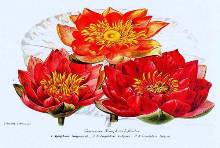|
|
||
|
With new species and subspecies of waterlilies, some quite colorful, being discovered and brought to cultivation in the latter half of the 19th century, the possibilities for crossing them greatly increased. Though Eduard Ortgies pioneered the technique for purposeful hybridizing of waterlilies, documented by Jules Emile Planchon in Flore des Serres et des jardins de l'Europe, Volume 8, 1852-1853 (French - English), it seems that new waterlilies were limited to a fairly small number of garden varieties for quite some time. It took an article by Charles Antoine Lemaire about Nymphaea Devoniensis, which appeared in the Belgian publication Le Jardin Fleuriste in 1854, to inspire a Frenchman to explore the potential of hybridizing waterlilies. He was Joseph Bory Latour-Marliac. Lemaire and the other writers of the time reported supposed crosses of hardies with tropicals but there is no evidence any were successful. Nevertheless, creating them was the dream of many including Latour-Marliac, as it is of hybridizers today. |
||
|
We don't know for sure if or when Latour-Marliac found the Planchon article, or if he developed the technique for hybridizing waterlilies on his own, but we do know he struggled for some years before introducing his first hybrid, sending N. 'Marliacea Chromatella' to Kew Gardens in 1887. A dazzling array of hardy hybrids followed, more than 100 attributed to him today, making him arguably the greatest hybridizer of all time. Descriptions of many of them can be found in articles from Revue horticole. His own account of his early efforts appeared in The Garden, 1893. There he claimed to have successfully crossed hardy lilies with tropical night bloomers but there is no scientific evidence to support this. Nymphaea odorata sulfurea and
Eichhornia azurea |
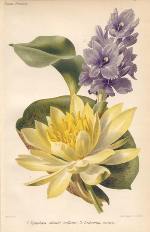 |
|
|
At about the same time, another Frenchman, Antoine Lagrange, was introducing new hybrids as well. His first, N. 'Marie Lagrange', named for his wife, was a deep pink tropical night bloomer and was introduced in his 1899 Catalogue. In the following years, Lagrange introduced a succession of tropical day and night bloomers as well as some hardies. Nymphaea 'Marie Lagrange' |
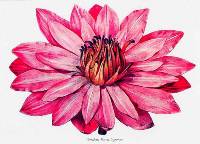 |
|
|
Though none of the Lagrange cultivars are still in cultivation, there was obviously a rivalry between Lagrange and Latour-Marliac at the time. Both entered numerous competitions, winning top prizes for their creations, and vied for prominence in France. It was Lagrange who provided the aquatic plants for the most prestigious lily pond in France, Paris' Bagatelle, from 1908 through at least 1912, featuring many of his own creations and those of other hybridizers. After that, it was the Establishment Latour-Marliac that provided the plants. Aquiculture Lagrange ceased to exist for reasons we don't know. The competitions and exhibitions may provide the reason some of the cultivars reported in the literature of the time have disappeared. Could it be that these were fabulous hybrids, worthy of admiration and prizes, but difficult or impossible to propagate? A possible example of this appeared in a report on "Les Plantes Aquatiques a l'Exposition et Les Nymphéacées Nouvelles", Revue horticole 1900: Latour-Marliac's N. 'Mosaique'. The description is similar to that of N. 'Arc-en-Ciel' but it was only mentioned the one time. |
| Impressionist painter Claude Monet played an important role in popularizing waterlilies. At Painting-Photography-France.com, "The Lot-et-Garonne and Claude Monet", we find this: | ||
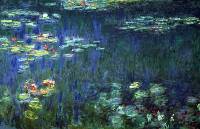 Claude Monet Waterlilies, Green Reflection, Left Part 1916-1923 Orangerie, Paris Image from WebMuseum |
". . . He once said, 'It took me time to understand my nymphaea; I planted them for pleasure without dreaming of painting them. Suddenly I felt there were fairies in my pond. I took up my brushes and palette and, since then, it has been almost my sole model.' . . . Situated close to the confluence of the rivers Baise, Lot and Garonne, Les Ets Botaniques Latour-Marliac was founded in 1875 by Joseph Latour-Marliac who created the first hardy hybrid nymphaea in multiple colours. When these incredible hybrids were exhibited in Paris they caught the attention of Claude Monet whereupon he immediately began placing orders for them for his garden at Giverny. In 1904, whilst on his way to Spain, he came here to the Lot-et-Garonne to see for himself the source of his inspiration." | |
|
|
||
| At the same time that Latour-Marliac and Lagrange were changing the waterscape in Europe, several Americans were hoping to do the same in the United States. Edmund D. Sturtevant opened the first aquatics nursery in the US in 1876, located in Bordentown, New Jersey. He assembled an extensive collection of waterlilies from all over the world, introducing many to the public, including several of his own chance seedlings, largely hybrids of N. gracilis. Sturtevant moved the nursery to the milder climate of Hollywood, California, about 1894. In 1921, it was sold to Harry Johnson and it became Johnson Cactus and Water Gardens. | ||
| Already well established as a seed and bulb company based in Philadelphia, Henry A. Dreer Nurseries ventured into aquatics sometime in the early 1890's. The nurseries were located in Riverton, New Jersey. They are perhaps best known in water gardening for introducing N. 'James Brydon', N. 'Wm. Doogue' and N. 'William Falconer' in 1900, the first American hardy hybrids thought by some to rival Latour-Marliac's creations. |
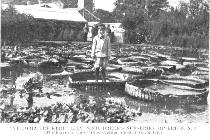 Victoria at Dreer's Nurseries Image from Riverton Public School Riverton Project |
|
|
William Tricker published his classic book, The Water Garden, in 1897. In it he described Nymphaea pulcherrima, later known as N. 'Blue Beauty', as a "Garden hybrid of American origin". The description indicates that this perhaps best known Tricker hybrid was a chance seedling of N. caerulea rather than the result a purposeful cross. It was very similar to a hybrid created by Henry S. Conard in 1900 named N. 'Pennsylvania', also later known as N. 'Blue Beauty'. To understand how this occurred, read The Saga of 'Blue Beauty'. N. 'Pennsylvania' |
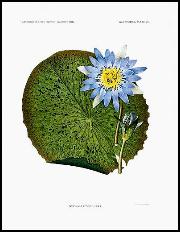 |
|
| Two great gardens in St. Louis, Missouri, were also deeply involved with the development of waterlily hybridization thanks to Henry Shaw. He opened what later became Missouri Botanical Gardens to the public and hired James Gurney, recently from the Royal Botanic Gardens, Kew, as head gardener in 1867. The next year, Shaw founded Tower Grove Park, where water features were an integral part of the design. Gurney was largely responsible for the design and became superintendent on Shaw's death. He became well known for his work with waterlilies, particularly night blooming tropicals, so appropriate for the excellent lighting for evening viewing at Tower Grove Park. |
|
||
|
Next - Missouri Botanical Gardens' George H. Pring |
References
André, Edouard. Revue horticole, 1900.
Berghs, Father J.M. Articles in Water Garden Journal, 1989-1993.
Berry, B.C. "Nocturnal Hybrid Water-lilies of the Late James Gurney". Missouri Botanical Garden Bulletin, 10(9), November 1922, p. 147-150.
Conard, Henry S. The Waterlilies, A Monograph of the Genus Nymphaea. The Carnegie Institution of Washington. 1905, Chapter VII.
Innes, William T. Goldfish Varieties and Water Gardens. Innes Publishing Company, Philadelphia 1947, 1949.
Latour-Marliac, J.B. HARDY
HYBRID WATER LILIES. THE GARDEN, March 18. 1899.
Extract from a paper read before the Royal Horticultural Society,
August 9, 1898.
Masters, Charles O. Encyclopedia of the water-lily. T.F.H. Publications Inc. Ltd., Neptune City, NJ 1974.
Missouri Botanical Garden Web Site.
Painting-Photography-France.com, "The Lot-et-Garonne and Claude Monet".
Pagels, Walter. The Saga of Blue Beauty.
Pagels, Walter. Personal communication, December, 2005.
Planchon, Jules Emile. 'Ortgiesiano-rubra', Flore des Serres et des jardins de l'Europe, Volume 8, 1852-1853 (French - English)
Robinson, William. 1887, . Canary Water Lily. THE GARDEN, July 23, 1887.
Robinson, William & Latour-Marliac, B. The New Hardy Waterlilies. The Garden, December 23, 1893.
Sturtevant, Edmund D. Aquatics in California. Garden and Forest, December 9, 1896
Tricker, William. The Water Garden. A.T. La Mare Printing and Publishing Co., Ltd., New York, 1897.
Victoria-Adventure Web Site, Biographies
Vilmorin, Maurice-L. LES NYMPHAEA RUSTIQUES - French (THE HARDY WATERLILIES - English) Revue horticole 1891.
